Knowledge Products > Details
Improved Water Governance: Towards Sustainable Agricultural Development, Azerbaijan

For the first time in Azerbaijan, healthy potato seeds produced in laboratories have been propagated and planted in the open field
©FAO
Water scarcity has become a potential threat in Azerbaijan due to the changes in climate that resulted in reduction of rainfall, increased heat, diminishing water flows and run-off, as well as increased demand for water and agricultural products as a result of population growth and economic development. The infrastructure of the irrigation system which has been inherited from the Soviet era is also quite old, resulting in significant water losses, especially in canals established in soil and lacking concrete insulation. The issue is further complicated by the fact that around 70 percent of the water used in Azerbaijan originates in other countries. As the water scarcity reached critical point in 2020, affecting the agricultural production, an acute necessity for greater governance of water resources and rationing of water between different producers has emerged.
In response to this challenge, the President of the Republic of Azerbaijan has issued an order on 15 April 2020 that has established a commission on coordinating water management issues and another one on 27 July 2020, that has approved the “Action plan on ensuring efficient use of water resources for 2020-2022". The Action Plan includes items such as establishment of an electronic water works information system, development of a National Strategy on effective use of water resources, development of new incentives for water saving technologies for agricultural producers and awareness raising activities for more effective water use.
The main FAO-TCP objective is to strengthen national capacity in the field of analysis, planning and coordination for water resources management in Azerbaijan. The TCP’s major outcomes are expected to be improved agricultural productivity and food security, increased conservation of land and water resources and increased resilience of agriculture to impacts of climate change. For more information, click here.
Documents
Related resources
- State Programme on Reliable Food Supply of Population in The Azerbaijan Republic (2008-2015).
- Azerbaijan Works Towards Consolidating Fragmented Land
- Governance of Tenure
- Voluntary Guidelines on the Responsible Governance of Tenure
- FAO-Turkey Partnership Programme on Food and Agriculture (FTPP II)
- Practice of Conservation Agriculture in Azerbaijan, Kazakhstan and Uzbekistan
